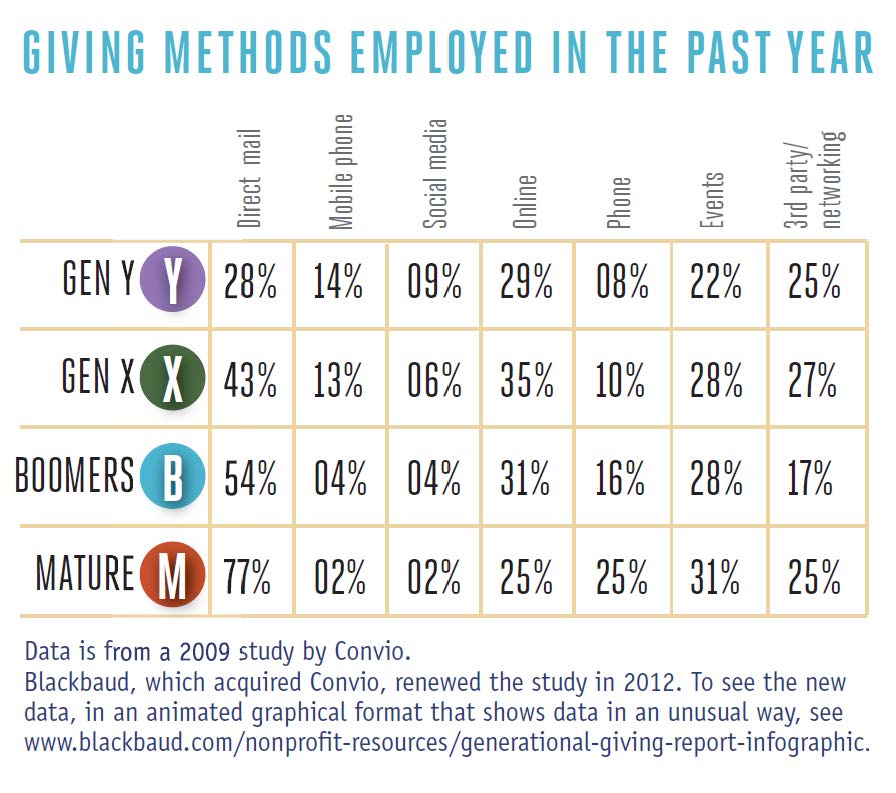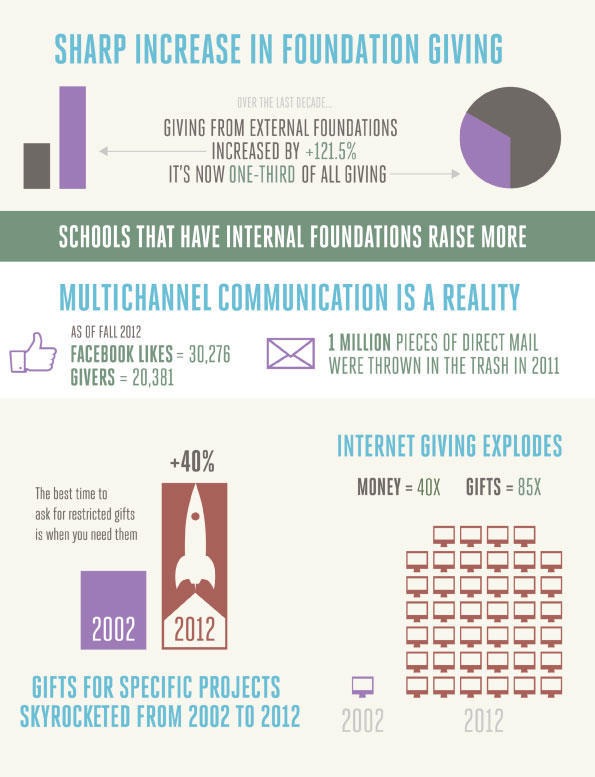This is the second in a series of articles on the rapidly changing environment of theological education. The first in the series, “More Schools, Fewer Students,” appeared in the Autumn 2013 issue and is available at www.intrust.org/moreschoolsfewerstudents.
Times are tough for raising financial support for seminaries. Whether your school is in the United States or Canada, research affirms the difficulty of resource development these days. Simply put, North Americans have become less charitable in the past 40 years.
That’s a strong statement, but the data reflect it. In 1971 Americans gave about 2.1 percent of the nation’s gross domestic product (GDP) to charitable causes. But in 2011, that figure had dipped to 2.0 percent.
Let’s throw another wrinkle into the mix.
In 1971, 200,000 charitable organizations competed for giver dollars; today that number has burgeoned to 1.5 million (see http://bit.ly/henson1). Significantly more nonprofits — 7.5 times more — are actively seeking donations. Our role in rallying givers to fuel the work at our schools is as important but as difficult as ever.
Canadian research illustrates similar challenges and additional insight regarding the sources of gifts. Statistics Canada reports $10.6 billion in charitable giving in 2010. That study also reveals that people become more charitable with age, and 83 percent of gifts flow from the top 25 percent of the giving households. Givers are especially generous in supporting religious causes, a fact that offers a ray of hope (see http://bit.ly/henson2).
A 2007 survey of giving in Canada showed that from 1997 to 2007, the percentage of tax filers who claimed charitable gifts declined from 25.7 to 24 percent (see http://bit.ly/henson3). Other studies show participation through giving has declined in Canada since 2007. This may be one of the reasons that the Canadian International Development Agency encourages first-time givers to take advantage of a special tax credit (http://bit.ly/henson4). To get more people to start giving, the Canadian government offers incentives.
 |
| Click image to enlarge. |
The landscape is changing for nonprofits in general. How is it changing for seminaries? We’ve conducted some peer research to help us answer that question. Over the past decade, a group of 8 to 12 seminaries (enumerated on page 8) has shared advancement data in order to understand our times and increase the efficiency and effectiveness of development efforts. Here are seven findings from the most recent study.
1. Annual fund giving is topsy-turvy. None of the peer seminaries are experiencing 5 to 10 percent growth year over year, so why have many schools historically budgeted that way? Seminaries that raise more money are shifting their emphasis from seeking major gifts to reach annual giving goals to utilizing the annual fund as a means for rallying widespread participation. Then they ask faithful supporters to make temporarily restricted gifts to fund special projects or initiatives.
2. Temporarily restricted giving has skyrocketed. Over the past decade, the peer schools collectively saw giving for projects rise 40 percent. Despite trying times, this affirms the axiom that “the best time to ask for restricted gifts is when you need them.” People respond to opportunities to make a visible impact.
 |
| Click image to enlarge. |
3. Seminaries with foundations are raising more money.
Most major gifts are planned gifts, which are more complicated transactions. Consequently, many schools are forming internal foundations to facilitate such gifts. These schools are raising more money by helping people transfer their wealth, which they acknowledge is a gift from God, to God’s work.
4. Charitable foundations have helped carry seminaries. Giving over the past decade from external foundations to our peer group increased 121.5 percent and represents almost one-third of all support. Just as in Genesis 41, Joseph “opened the storehouses” of Egypt in the days of famine, foundations both large and small have generously shared resources with theological school. (A question for every board: What is your seminary doing to engage both big-name, multibillion-dollar foundations and smaller family foundations?)
5. With online giving, the future is now. What began as a trickle is now a flowing river. Internet giving has increased 40 times in dollars and 85 times in participation in the past decade for the group of peer schools we studied. (A question for boards: How is your school driving givers to your website, and how easy is it for the public to give? It better be really easy.)
6. Facebook “likes” are on the upswing. In 2010 our peer group of 12 schools had a combined 20,381 givers and 21,570 Facebook likes. While the support base has remained flat, in two years the number of our Facebook “likes” has grown 40.4 percent to 30,276. Our people want to connect with our schools through social media. How is your school using it?
7. A million pieces of mail went to the trash. In our 2012 study we found that our 12 peer schools sent approximately a million pieces of direct mail that went straight to the trash. This was a wakeup call that caused us to examine this costly communication channel. As a result, our schools determined that while we still need to use “snail mail,” we need to use it more strategically.
Changing methods in a multichannel world
The chart, which is based on Convio research from 2009, shows that theological schools would do well to provide multiple channels for givers rather than relying solely on direct mail. (To see the new data, in an animated graphical format that shows data in an unusual way, see www.blackbaud.com/nonprofit-resources/generational-giving-report-infographic)
Some major findings:
• Direct mail. The mature generation still responds well to this method of communication, but with each younger generation, direct mail declines in importance.
• Mobile devices and social media. Giving through these means is growing sharply among the younger generations.
• Internet giving. All generations are equally comfortable with giving on the web. All communications and solicitations should offer an Internet giving option.
• Phone appeals. Telephone-based giving is dying out with the older generation.
 |
| Click image to enlarge. |
• Events. Giving at fundraising events is reasonably constant across age groups. Young or old, people like gathering with others to support a cause they believe in.
• Networking. Boomers may be getting burned out from networking events, but other age groups do engage in this manner.
It’s important to note that the youngest group, Generation Y, has no column with more than 30 percent. This is a multichannel group that should be approached on several platforms simultaneously.In fact, as schools reach out to constituents across multiple platforms, they become more effective at engaging constituents and rallying participation. Why is this so important? Giving USA reveals that educational institutions are not high on most people’s priority lists. Furthermore, in recessionary times, giver support for human services increases, which makes sense, since financially stable persons may want to do their part to serve others in need. In recent years, giving to human services has gone up 6 percent to 7 percent a year, while giving to religion has decreased about 2 percent.
Looking ahead
Your analysis and discussions with peers will prepare you for the next article in this series. For now, we offer this preview: Many ATS leaders have found that rallying support for schools is not simply a strategic task but also a spiritual one. That is, we are trying not merely to raise funds for our seminaries, but we’re raising givers for the church and the kingdom of God.
People expect theological leaders to offer counsel and insight in this area. In the next issue of In Trust, we will share some best practices for the spiritual and strategic work of rallying people to participate in advancing the mission of theological schools in the United States and Canada.
The peer schools
From 2004 to 2009, the peer group that we studied included these seminaries: Asbury, Covenant, Dallas, Denver, Fuller, Gordon-Conwell, Reformed, and Western (Oregon). From 2011 to 2013, the group expanded to 12: Asbury, Ashland, Covenant, Dallas, Fuller, Gordon-Conwell, Northeastern, Northern, Phoenix, Reformed, Western (Oregon), and Westminster.
WHAT DOES THIS MEAN FOR SEMINARIES?
In light of the findings presented in this article, we believe theological schools should look at their own data, revise development strategies to make them more multichanneled, and share best practices with peers at similar schools.
Questions for board members and administrators:
1. What are your seminary’s giving trends?
How does your school’s giving compare with national giving trends reflected in reports from Giving USA or Statistics Canada? Take an honest look. If you were to plot your school’s 10-year contribution numbers on a graph, what would you conclude? Is your support base growing or shrinking? What does your individual giving look like? What about foundation, church, board, and alumni giving? The goal is to see and understand your history and then adjust your strategies accordingly. In so doing, don’t forget about deferred giving. How much do you receive each year from matured estates? Are you asking people to include the seminary in their estate plans?
2. Is your school engaging people through multichannel communication?
What does your seminary’s “asking strategy” look like? Is it just a Number 10 envelope at year-end seeking an annual gift? What other channels are you using, and how have people responded? Since different channels require different amounts of time, do you have adequate staff for rallying constituents to participate in the mission of your school with consistent multichannel messaging?
Many seminaries have one staff member in charge of all seminary relations, from alumni to development, and they wonder why giving has leveled off. Is it time to hire students or mobilize volunteers to assist with social media and other efforts, inviting people either to give annually or to support specific projects that may shape the future of your school?
3. Are you discussing findings with your peers?
In 2012, the 273 ATS schools received $386 million in gifts for operations. The median amount received was $758,000, down 6 percent from the previous year.
While this information helps place your school in the context of the industry, we have found that developing a strong group of peers is even more valuable. Through peer study analysis and data sharing, our schools have benefited and our programs have improved. Over the decade of peer research, we have concluded that people still give to people. Budgets are tight and the best way of engaging giving is through personal contacts. But when constituencies number in the thousands, we need to maximize multichannel mediums to increase engagement and giving.